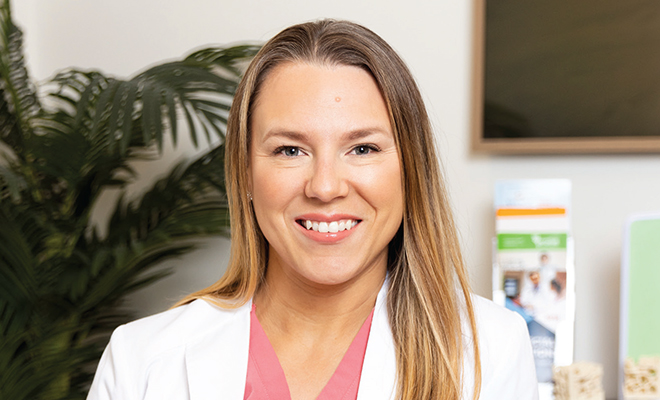 Amber Deery
Amber Deery
Dr. Shannon Carpenter: Fracturing the Misconceptions About Bone Health
During their lifetimes, one in three women and one in five men over the age of 50 in the U.S. will suffer at least one fracture, either the result of a fall or simply a compression break due to poor bone quality. These statistics surpass the number of people with heart disease, breast cancer and stroke combined. Unfortunately, too many Kansas Citians are not building for the future by creating and maintaining good skeletal health to last their lifetimes. With The Bone Health Clinic, Dr. Shannon Carpenter and her “one-stop shop for bone health” work with patients to construct stronger bones to ensure longevity for women and men.
“At the Bone Health Clinic, I’m treating bone health and filling that care gap between what typically a primary care doctor or an endocrinologist, a specialist in diagnosing and treating health conditions related to problems with the body’s hormones, hormonal glands and related tissues, would do. Unfortunately, this type of preventive care has fallen through the cracks of overall wellness,” she advised. “At the Bone Health Clinic, we work on the prevention, diagnosis and treatment of osteoporosis. We’re looking at fracture risk for men and women in a holistic way. We call it a one-stop shop for your bones.”
BREAKING THE CYCLE OF BROKEN BONES
Poor bone health and the diseases attributed to it are rising at an alarming rate in people, especially women. According to Dr. Carpenter, this spike is caused by two factors. Lifespans are increasing and as we age the body draws down on our bone density. Women reach their peak of bone mass or density at about 35 years, and life expectancy a few generations ago averaged only 55 years. But now we are living much longer and fracture risk has increased because of it. Also, many women are living sedentary lifestyles, which does not maintain bone density. Exercise and good eating habits are critically important to ensure women protect their bones.
“Have a well-rounded diet that includes adequate calcium and vitamin D intake. Many of us are vitamin D deficient and we don’t even know it, so have it checked by your physician and make sure you’re supplementing it adequately. Also, do not live a sedentary lifestyle; engage in weight-bearing exercise. We lose muscle at the age of 35 if we don’t do something to actively rebuild it. Avoid excessive alcohol use, and smoking is really bad for your bones. If you have any health conditions that may affect your bones, such as diabetes, make sure you’re getting your bone health checked out sooner rather than later,” she remarked. “Most importantly, really take advantage of the opportunity to take care of yourself. Make sure you’re doing something physically active to help maintain muscle mass and bone density.”
LEARNING AT A YOUNG AGE
Throughout her entire life, Dr. Carpenter has been close to the healthcare field. Her mother was a nurse, and the youngster enjoyed reading her mother’s medical books and journals more than playing with dolls. She graduated from the University of Chicago Medical School and completed her orthopedic residency at William Beaumont Hospital in Royal Oak, Michigan, one of the country’s top orthopedic hospitals. She completed her fellowship in shoulder and elbow surgery in Baltimore before moving to Kansas City. At HCA Midwest Health Overland Park Regional, she treated a range of orthopedic and trauma cases. In 2020, she strengthened her commitment to patient care with her decision to serve military veterans at the VA Kansas City Healthcare System.
In 2022, she added to her medical resume by opening the first standalone bone health clinic focused on fracture prevention. This initiative highlights her proactive approach to healthcare, filling a crucial gap in our community and working across several medical healthcare organizations to achieve the highest quality of bone health for her patients.
BONE HEALTH DISEASES
The numbers are mind-boggling. During their lifetimes, one in two women and one in three men can experience a compression fracture, which is typically caused by a loss of bone mass as a part of aging and occurs in the thoracic region of the spine. A fall, cough or simply lifting an object as heavy as a laundry basket may cause a fracture of the backbones. Several different types of diseases can attack bone health in men and women, but in most cases, females suffer more bone issues. One is osteoporosis, which causes bones to become weak and break easily and normally affects older women. The other is osteopenia, a loss of bone mineral density, and is usually the first step in developing osteoporosis. Unfortunately, osteopenia usually develops without any signs or symptoms until it moves to osteoporosis. However, the condition can be detected when a person has a bone mineral density screening or a DEXA scan, or dual X-ray absorptiometry. The device measures bone density, which is the thickness and strength of bones, by passing X-ray beams through the body, usually in the hip and the spine. Patients are scanned while lying down on the bed of the machine. DEXA scans are pain free and an important segment of the strategy to identify issues and form a treatment plan.
“Our DXA, an enhanced version of DEXA, scan checks a trabecular bone score that looks not only at the bone density, but the micro-architecture or organization of the bone,” remarked Dr. Carpenter. “It is a new and powerful tool that provides important information regarding a patient’s fracture risk.”
While it may seem that poor bone health is unavoidable as people grow older, Dr. Carpenter emphasizes that no matter the age of the patient, steps can be taken to build bone mass, improve body balance, prevent fractures and decrease fracture risk. But it is up to the individual, guided by his or her healthcare provider, to do the right things to ensure good bone health for the future and prevent broken bones that can result in health problems and disability.
“Bone health is a massive, massive issue that just doesn’t get talked about in the medical community and with patients. It’s important to be proactive with your bone health and discuss with your healthcare provider the direction you want to drive for your wellness in the future,” noted Dr. Carpenter. “Unfortunately, women can think their bones are fragile and they shouldn’t do anything but sit in a chair. But that’s exactly the opposite of what we want someone to do. We want you to have an active lifestyle because if you’re sedentary it makes things worse. But some women are so afraid that they’re going to slip and fall and break a bone that they just don’t do anything. That must change.”
The Bone Health Clinic providers complete a comprehensive assessment of risk factors for bone disease and falls for every patient. The mission of the organization is to reduce fracture risk by optimizing nutrition and supplements, developing a comprehensive fall risk assessment and addressing any muscular weakness or postural imbalances through specific exercise programs. The latest prescription medications can be given as needed. Each patient receives a customized two-year treatment plan to optimize their bone health. If approved by the patient, this comprehensive plan is shared with the individual’s primary care doctor or referring physician.
Dr. Carpenter works with women, the bulk of her practice, and some men, with the hope of improving their bone health. Generally, they fall into two categories. The first is a patient who has been referred by an orthopedic surgeon after the patient has fallen and broken a bone. The orthopedic corrects the break with surgery but sends the patient to The Bone Health Clinic to prevent future breaks. The second group falls into an age range of 45 to 55 years old and may be menopausal or perimenopausal.
“These are the women interested in preventive healthcare. They want to know what they should do to avoid being in that situation of poor bone health. We share with them a lot of preventative counseling, but we also establish a baseline of bone health to follow over the years,” she said. Dr. Carpenter points out that women hit a peak bone mass at the age of 35, so establishing a baseline before entering menopause is particularly important for a solid strategy for the future.
GROWING FOR THE FUTURE
At this time, the Bone Health Clinic is in Lenexa, Kansas, but Dr. Carpenter’s long-term goal is to create a national telehealth system that can assist women and men across the country to achieve good bone health. She is dedicated to growing her business and offers this advice to other entrepreneurs working to set up their own companies.
“I had an idea that I would start with a medical clinic for bone health but I had no clue what that would entail. But I worked with my husband, Eric, who is an entrepreneur, to establish my vision. You have to have the tenacity to really understand why you’re doing this, and that gets you through the really hard days. What drives me is that I want to make sure that osteoporosis is eradicated by the time my seven-year-old daughter, Adeline, is an adult,” she shared. “Also, I want to make sure my patients have access to the bone health treatment that they need. Lastly, you have to have a really good team, because no one is a success by themselves. So spend a lot of time to find that team, build it and then lead it because that’s what will get you through the difficult spots.”
Her goal is ambitious but so needed by health care professionals and the patients they serve. The potential to be negatively impacted by poor bone health is astronomical, impacting one out of every two women with compression fractures or broken bones. But the opportunity is now to become educated and prevent fractures.
“I want people to live in the life that they’ve earned. It’s not fair that when you get into your later years, when you’re supposed to be enjoying life, but now you’re afraid to do the things you want to do because you’re afraid of breaking a bone,” remarked Dr. Carpenter. “I want to encourage women and men that now is the time to work on developing good bone health to live a good life in
the future.”












